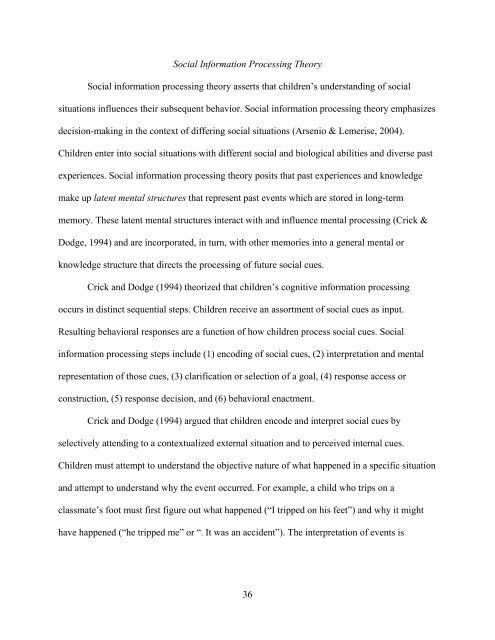Copyright Malvin Porter, Jr. 2010 - acumen - The University of ...
Copyright Malvin Porter, Jr. 2010 - acumen - The University of ...
Copyright Malvin Porter, Jr. 2010 - acumen - The University of ...
You also want an ePaper? Increase the reach of your titles
YUMPU automatically turns print PDFs into web optimized ePapers that Google loves.
Social Information Processing <strong>The</strong>ory<br />
Social information processing theory asserts that children’s understanding <strong>of</strong> social<br />
situations influences their subsequent behavior. Social information processing theory emphasizes<br />
decision-making in the context <strong>of</strong> differing social situations (Arsenio & Lemerise, 2004).<br />
Children enter into social situations with different social and biological abilities and diverse past<br />
experiences. Social information processing theory posits that past experiences and knowledge<br />
make up latent mental structures that represent past events which are stored in long-term<br />
memory. <strong>The</strong>se latent mental structures interact with and influence mental processing (Crick &<br />
Dodge, 1994) and are incorporated, in turn, with other memories into a general mental or<br />
knowledge structure that directs the processing <strong>of</strong> future social cues.<br />
Crick and Dodge (1994) theorized that children’s cognitive information processing<br />
occurs in distinct sequential steps. Children receive an assortment <strong>of</strong> social cues as input.<br />
Resulting behavioral responses are a function <strong>of</strong> how children process social cues. Social<br />
information processing steps include (1) encoding <strong>of</strong> social cues, (2) interpretation and mental<br />
representation <strong>of</strong> those cues, (3) clarification or selection <strong>of</strong> a goal, (4) response access or<br />
construction, (5) response decision, and (6) behavioral enactment.<br />
Crick and Dodge (1994) argued that children encode and interpret social cues by<br />
selectively attending to a contextualized external situation and to perceived internal cues.<br />
Children must attempt to understand the objective nature <strong>of</strong> what happened in a specific situation<br />
and attempt to understand why the event occurred. For example, a child who trips on a<br />
classmate’s foot must first figure out what happened (“I tripped on his feet”) and why it might<br />
have happened (“he tripped me” or “. It was an accident”). <strong>The</strong> interpretation <strong>of</strong> events is<br />
36

















